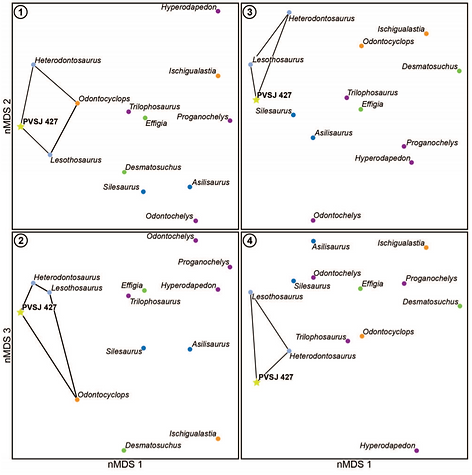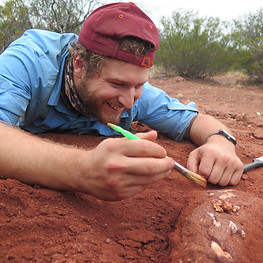
RESEARCH
A review of vertebrate beak morphologies in the Triassic: a framework to characterize an enigmatic beak from the Ischigualasto Formation, San Juan, Argentina
In this project we sought to identify whether or not a natural cast of a beak preserved any original biologic material and how this cast compared to other beaked taxa. My collaborators focused on reconstructing the diagenesis of the beak through thin sectioning and petrographic analyses. I focused on reviewing the shape and form of vertebrate beaks and using that as a framework to reconstruct an adaptive landscape of beak morphology. We use non-metric multidimensional scaling to deal with categorical data in reconstructing overall similarity between the different beaked vertebrates. We find our strange little beak to be most similar to ornithischian dinosaurs, which is exciting given that there are no confirmed ornithischian dinosaurs from the entire Triassic Period. The figure to the right shows the nMDS plot and the distribution of beak morphologies.

Euselachian diversity through the uppermost Cretaceous Hell Creek Formation of Garfield County, Montana, USA, with implications for the Cretaceous-Paleogene mass extinction in freshwater environments
In this project my collaborators and I described species of shark from the latest Cretaceous Hell Creek Formation. We then used our new classifications to assess diversity dynamics throughout the formation and how that diversity changed leading up to and across the end-Cretaceous mass extinction. The figure to the right shows the distribution of taxa throughout the formation. We find that all shark taxa go extinct at the end of the Cretaceous but display diversity patterns within the formation that are more similar to terrestrial mammals than to more aquatic salamanders or turtles.

A detailed description of Rugarhynchos sixmilensis, gen. et comb. nov. (Archosauriformes, Proterochampsia), and cranial convergence in snout elongation across stem and crown archosaurs
The first chapter of my dissertation sought to redescribe cranial material of an enigmatic archosauriform reptile, following extensive preparation of the cranial material. We find that the original authors (one of which was included in this paper) were correct in their taxonomic assessment, but incorrectly attributed the entire right-side of the skull to solely a right maxillary fragment. The figure to the right shows the cranial material and the affinity of the associated elements. After reassessing the material, I then sought to reconstruct an adaptive landscape of cranial evolution across stem and crown archosaurs. We found overall convergence in snout elongation across stem and crown archosaurs based on a non-metric multidimensional scaling analysis, using a matrix and characters from work done previously by Dr. Michelle Stocker (also an author on this manuscript).

Evolutionary homology in the fin-to-limb transition: evaluating the morphology of foramina in a Late Devonian humerus from the Catskill Formation, Clinton County, Pennsylvania.
In this project my collaborators and I sought to assess the foramina (a, b, c, and d in the figure to the right) in a Late Devonian humerus from Pennsylvania, and the evolution surrounding those foramina across the fin-to-limb transition. The figure to the right shows that only one of the foramina within the prominent ventral ridge fully perforates it, and the rest terminate prematurely. With this, we postulate that this represents the ossification around neurovasculature with the rotation of the forelimb in early tetrapodomorphs. Vasculature that is either unneccesary or not accompanied by nerves closes (premature termination) and does not preserve in the ventral ridge. As such, this highlights a key transition in vertebrate evolution, and the associated evolution of soft tissue during robust adaptation.


The first occurrence of Cynognathus crateronotus (Cynodontia: Cynognathia) in Tanzania and Zambia, with implications for the age and biostratigraphic correlation of Triassic strata in southern Pangea.
This, my first foray into paleontology, was an
exciting project where my collaborators and I
described the first occurrence of a species of
cynodont, based on teeth and limb bones,
in Tanzania and Zambia. We then used their
occurrence to evaluate how old these rocks must
have been, and how that correlates to Triassic
rocks around Pangea. The figure to the right
shows the pangeic correlations and our
hypothesis for the age of these rocks and this
animal.
